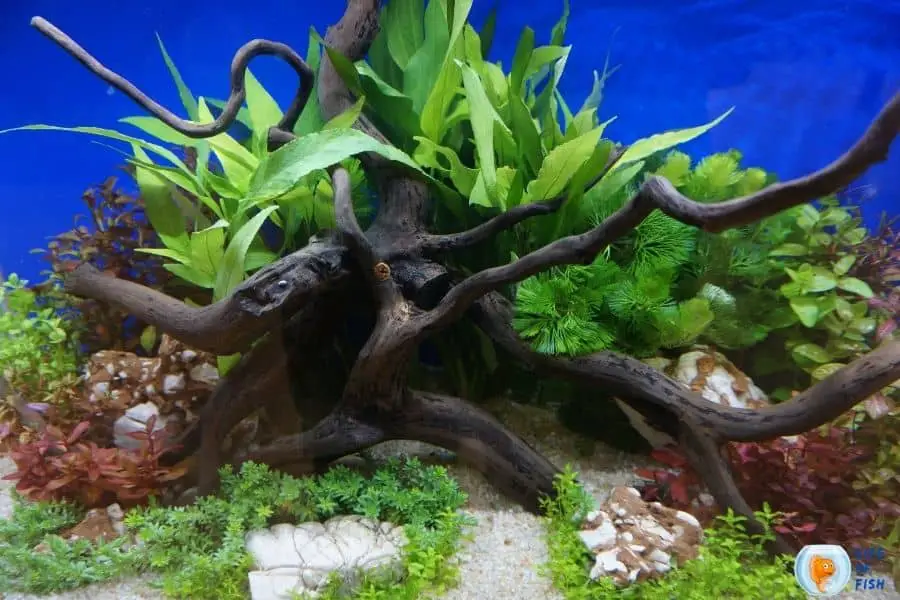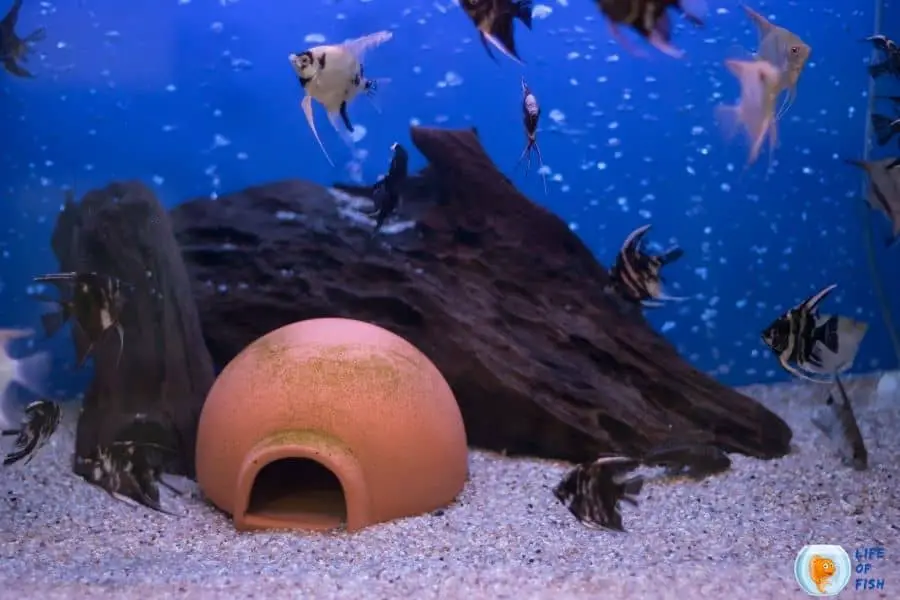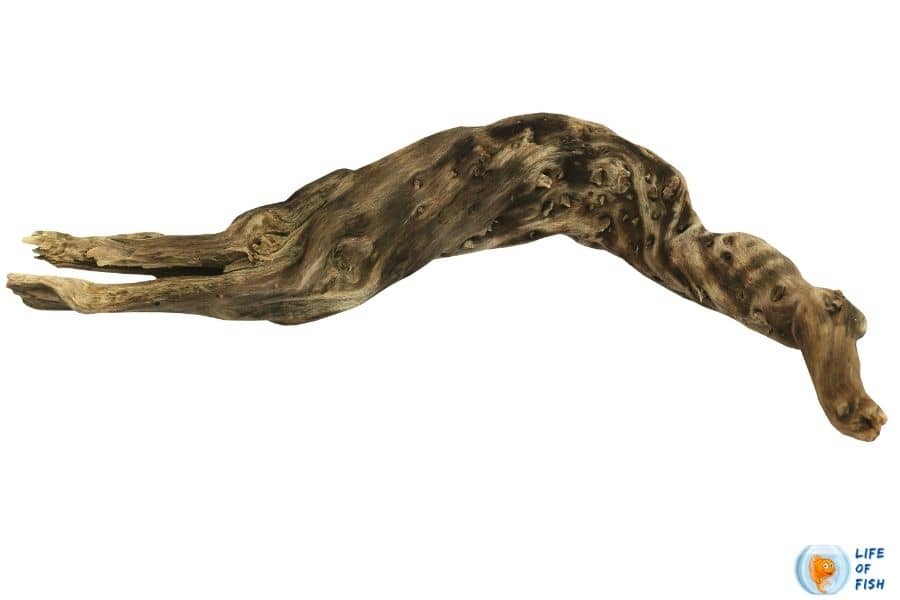Aquarium wood is a popular choice of most aquarists for aquascaping. A nice piece of wood can bring color and an elegant look into the aquarium while providing necessary hiding places to the aquatic life in the aquarium.
One may think that adding a piece of wood is so simple that washing it and putting it in the tank is all you need to do. Unfortunately, there are good reasons for you to clean and treat the wood before putting it in your aquarium.
Just washing the wood doesn’t make it safe for aquarium use. You have to treat it so that it would not leech tannins and other organic compounds into the water and affect the water quality. It is important to ensure that you treat the wood to neither rot nor discolor the water.
This is a guide on How to make wood safe for aquarium use.

Can I use any type of wood in my aquarium?
Jump To
No. You can not use any type of wood in your aquarium.
Wood that you can buy from the pet stores is treated wood. You don’t need to treat them at all before using them in your aquarium, and they would not contaminate your tank water.
Untreated wood is only safe to use if it comes from the clean running stream. The water running through it would wash away any tannin and other organic wastes coming from the wood.
However, as responsible hobbyists, we should not use driftwood from natural sources because we cannot be too certain that it is free of harmful insects and other parasites.
You can, however, treat the wood and make it safe for your aquarium. Still, some wood types may not be safe even after treating them.
Is oak wood safe for aquariums?
Oak is a widely available wood in the US, and it is considered aquarium safe. By this means, it usually doesn’t contain harmful chemicals and doesn’t affect the water quality of your tank.
Oak is not safe for aquariums if it comes from certain regions of the country. Oakwood can come from different parts of the country, and some types may contain chemicals that are bad for your aquarium fish.
Still, you can make it safer by treating the wood. There are several ways to treat wood which we will discuss below.
Is manzanita wood safe for aquariums?
Manzanita is considered one of the best wood for aquarium use as it does not leech any color or tannins into the water.
Additionally, they come in beautiful shapes and colors that do not disappear for years. However, it can be hard to find manzanita wood.
Manzanita wood is safe even for sensitive fish, and you can guarantee that it would not contaminate your tank water when used for aquarium.
Is spider wood safe for aquariums?
Spider wood is safe and valuable as a food source for invertebrates in the aquarium.
As the wood eventually breaks down, it becomes a healthy food source for your aquarium life, so you don’t need to worry that it might rot in the tank. You can use this wood in any type of vivarium without worry.
Is reptile wood safe for aquariums?
Reptile wood or driftwood that is sold for reptiles in the pet shops is usually safe for aquarium use. There are some differences, though.
Most reptile woods are softwood like Grapewood that contains more tannins than hardwood. So, it may discolor your water faster than aquarium wood.
Further, they are generally not-treated wood, and they will eventually rot, if not fast. However, it will take about a year or two for the reptile wood to rot. So, if your fish can survive in blackwater tanks, you can safely use reptile wood in your aquarium.

Is grapevine wood safe for aquariums?
Grapevine wood is safe for aquarium use once it is boiled or cured. It is actually great for shrimp breeding as it provides protection and a lot of hiding places.
However, grape wood produces a lot of biofilms as it contains high sugar levels. Also, it may grow white bacteria when you keep it submerged.
While these may reduce the attractive look of this wood, both biofilm and bacteria are a good source of food for the aquarium inhabitants.
Further, grapevine wood also contains tannins that may discolor your aquarium. Still, you can remove tannins by boiling or soaking the wood in hot water before use. You can also soak it in hot water for several days to get rid of the tannins.
Is java wood safe for aquariums?
Java wood is the wood taken from coffee trees that stopped producing coffee beans. It is a safe wood for any type of vivarium, and it is an excellent source of food for invertebrates in the tank.
But, it usually contains high levels of caffeine which is harmful to aquarium fish when ingested due to its toxic nature.
Further, it can make the water very cloudy if not treated well. Some aquarists even declare that Java wood is not safe because of this reason. However, preserving the wood for several days in clean water can make it safe for aquarium use.
Is mangrove wood safe for aquariums?
Mangrove trees grow in saltwater, and it is not recommended to keep them submerged in freshwater tanks.
Mangrove produces high amounts of tannin, and the dark color of the water makes it difficult for your fish to see and navigate.
In addition, mangrove wood has a very sharp and rough texture that can injure your fish. And it will rot quickly compared to other types of aquarium wood. However, if you want a brackish blackwater tank, mangrove is perfect.
Is cedar wood safe for aquariums?
Cedar is not recommended for any type of vivarium due to its aromatic oils.
It can be dangerous, especially to your pets or fish, and it will contaminate water in no time. Besides, cedarwood is not suitable for aquarium fish.
If you want to use cedarwood in your aquarium, it may cause your fish’s gills to bleed, so you should be careful.
Is mesquite wood safe for aquariums?
Mesquite is a hardwood that you can use in aquariums. It does not contain harmful substances and will not affect water quality negatively.
Mesquite wood is not treated, so it will eventually rot in aquariums. However, you can slow the rotting process by soaking your mesquite wood in hot water for an hour and then soaking it again in clean water for a day or two. You can use softened mesquite wood as decoration.
The downside of mesquite is that it also contains tannins that may cause the aquarium water to be discolored.
You can remove tannins by boiling or soaking your mesquite wood in hot water for several days before use.
Further, it has an aroma that may be toxic to some fish species. So, better test the wood in a small fish tank with hardy fish after treating the wood.
Is pinewood safe for aquariums?
Pinewood has a sticky sap that can be harmful to aquarium fish. You can reduce the toxicity of pinewood by boiling it for an hour.
However, you should not keep your pinewood submerged for a long time. Further, you should treat pinewood with heat and bleach before using it as aquarium wood or decoration to prevent insects from attacking the wood.
Is driftwood safe for aquariums?
Driftwood is decayed wood pieces coming out of water streams. So, driftwood is safe to use in any type of vivarium.
It does not contain harmful substances, but it may be dangerous to your fish or pets if it is not cleaned properly before use.
Drifting wood makes the aquarium water cloudy, but you can prevent this by soaking your driftwood in hot water.
Also, soaking driftwood can remove unwanted substances from it, including harmful pesticides or fertilizers used to grow the wood, which is unsuitable for aquariums.
Suitable wood types for aquariums? What to consider?
As you can see, some wood types are not suitable for aquarium use because of the aroma, sap, pesticides, fertilizers, or tannins they contain. However, most wood types are ideal for aquarium use after treating the wood piece properly.
Further, any type of wood is ok to use in an aquarium if that piece of wood is dead and sitting in the sun for at least several months.
The wood will start to dry and become completely safe for aquarium use by exposure to the sunlight. So, it would be better if you find some dead wood pieces that have been sitting in the sun for a long time.
Do not use wood from live trees as aquarium wood because it could contain harmful substances, sap, and other elements.
Some recommended wood types for aquarium use are,
- Alder
- Apple
- Cherry
- Hawthorn
- Beech
- Heather
- Oak
- Sycamore and
- Pear
Some wood types are not recommended for aquarium use as they contain harmful elements. Some examples are,
- Horse Chestnut
- Walnut
- Cedar and other coniferous trees
- Cypress
- Grapevine
- Ivy
- Yew
- Lilac

Can I add wood to the aquarium as it is?
Adding wood as it is will not be a problem if that piece has been sitting out in the sun for a year. Still, experts recommend at least boiling the wood piece to kill any bacteria and parasites in it.
Some people use wood pieces of live trees in aquariums, but you should be careful when doing this. Live trees may contain harmful substances and other elements that can negatively affect water quality.
Further, the size of the wood piece may not fit your aquarium well. In that case, you will have to cut or break the wood piece.
For example, if you use driftwood for aquarium decoration, you can break it into smaller pieces by hitting it with a hammer.
On the other hand, big pieces of driftwood are quite hard to break by yourself, so it is better to find a company that sells driftwood pieces for aquarium use.
How to make wood safe for aquariums?
If your wood is a store brought one, boiling it for a few hours would be all you need to do since it is already treated. But, if you pick up a wood piece from nature, you have to treat the wood with different methods.
For example, if your wood is a driftwood piece, soak it in hot water for a few hours. Then, remove it from the water and let it dry in the sun for a few days.
Then boil the wood for several hours. You will have to repeat the boiling process several times until it stops releasing any smell or tannins into the water.
This will make your driftwood ready for use in your aquarium, but you can also try some alternative methods. Still, boiling it several times will be more beneficial since various microorganisms may be present in your wood.
If you pick a fresh wood piece, the process will be longer. You will have to keep it in the sunlight for at least a year or two. In that time period, the wood will dry and start to rot. Rotting the wood will get rid of any harmful elements from it.
Some people recommend keeping the wood piece in a running water stream for several months. A pond will also be fine, but make sure the water is not too dirty. If you can see any insects or worms in it, do not use that pond for this purpose.
After the wood is dried and decayed from either of the above methods, you must sterilize the wood by boiling it for several hours.
This process may take several weeks if you have a large driftwood or wood piece from nature. Again, it is important to boil the wood piece several times and then let it dry in the sun for a few weeks.
By following the above methods, you can make your wood safe for aquariums.
Related Questions
How long should you boil driftwood for the aquarium?
If your wood piece is small, about 1 to 2 hours of boiling is enough. Although it is a big piece, you have to boil it for a minimum of 3 hours.
If your wood comes from nature, boiling it for an hour or two is not enough. you need to boil several times, depending on its size.
Is wood glue safe for aquariums?
If the glue you are using is a Cyanoacrylate glue, it is safe for aquarium use. Epoxy glue and silicon glue are safe once they are cured.
Other types of wood glue are not safe for aquarium use since they may contain chemicals that will harm the fish and plants in your aquarium.
Where to get the best and safest wood for aquariums?
You can buy safe, inert pieces of driftwood or mesquite from various companies that sell them for aquarium use.
You can also find a piece of wood from nature and follow the methods described above to make it safe for aquariums.
Conclusion
Wood pieces are not only natural decorations for your aquarium, but they also help the fish stay safe and healthy by providing hiding spots.
Any wood piece would not be safe for aquariums before treating and sterilizing. You have to clean it well to remove dirt and rotten parts.
Then, you have to sterilize it before using it in your aquarium. If you are unsure about the wood you have found, it is better to get rid of it and opt for an aquarium wood sold at the aquarium shops.
Read Next : Is Gorilla Glue Safe For Plants? ( Yes And Few More Tips ) Is Hot Glue Toxic To Turtles? (No, But You Should Know This) Is Krazy Glue Safe For Aquariums ? | A Crazy Answer For You |
